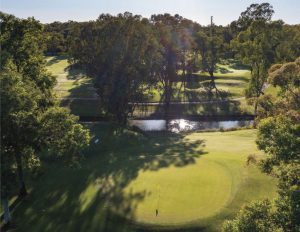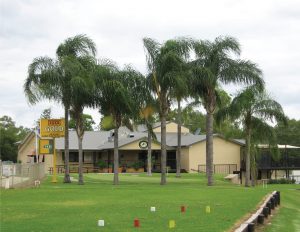Mother Nature and unheralded course designer, ArthurEast, conspired to create
a simple butfun layout that has with stood great floods and the test oftime.
Moree has been blessed by Mother Nature.
The small country town of less than 7,500 people is the hub of a fertile agricultural region producing wheat, cotton, olives, sheep and cattle. The largest pecan nut farm in the southern hemisphere is a 25-minute drive east of town.

That’s on top of the ground. Under the ground, there is the Great Artesian Basin, the largest and deepest groundwater holding in the world. This warm mineral-rich water has led to Moree and its surrounds gaining popularity as Australia’s artesian spa capital.
But as I recently discovered, this picturesque country town about 620km north of Sydney and 480km south west of Brisbane, has been doubly blessed by Mother Nature.
And it comes in the form of the par-72 layout at Moree Golf Club.
The course lies both sides of a bend in the twisting Mehi River and covers naturally rolling terrain, with tall stands of gum trees and a host of other native species densely lining its well-groomed kikuyu fairways.It wasn’t always this idyllic.
The club was formed in 1906 and founding members staked out nine holes with sand scrape greens on land where most of the back nine of the current course now lies.
That was golf in Moree for the next 50 years, until the arrival of PGA professional and course designer, Arthur East.

Arthur East was just 15 when he became an assistant professional, working with his older brother, Victor, at The Australian Golf Club.
He worked there for eight years before moving across town to work for Fred Popplewell at Concord Golf Club in 1915.
In 1922, Arthur and Victor went to the United States to take up club professional positions. Arthur was the professional at Chicago’s Elmhurst Country Club for eight years, during which time he made golf clubs and dabbled in course architecture.
After returning to Australia in 1930, Arthur became the professional at The Lakes Golf Club and later joined Victor and younger brother, Richard, in establishing the successful East Brothers club-making company (in the 1950s the company merged with Chesterfield to become Precision Golf Forging – PGF – one of Australia’s most popular golf club manufacturers for the next
50 years).

17TH IN TWO BUT YOU’LL GET MORE
TROUBLE FROM THE TREES HERE.
Arthur stayed at The Lakes until after World War II when he combined his enjoyment of teaching the game with course architecture. He was engaged by the NSW Golf Association to tour through the state, giving lessons and talks to members at dozens of clubs as well as advising club committees on how best they could improve their course.
There were few places in NSW Arthur East did not visit and, despite his impact on NSW country golf being little known today, he was a prolific designer and remodeller of courses during the 1950s.
In mid-May 1952, East arrived in Moree for three days, and as the local newspaper reported, for “professionaltuition for members and associates. His services will be available for 10/ (shillings) per half hour.”
It wouldn’t be the last time East would venture to Moree as the club then commissioned him to oversee the extension of the course to 18 holes and, ultimately, the conversion to grass greens.
East’s plan was to lay the course out on both sides of the Mehi River, but he had to consider any future flood events in considering the routing as well as how he would build the greens and tees. The greens most in danger of being inundated during flooding (there have been six significant floods since East’s redesign was completed) are pushed a little higher above the fairway, while several tees are located on the highest point nearest the previous green.
With the exception of constructing the greens and levelling of tees, it is understood minimal earthmoving was done in the creation of East’s design, which has changed very little in the past 65 years.

GOLF CLUB AND I WAS PLEASANTLY SURPRISED HOW
GOOD IT REALLY WAS.
It is eye-opening to consider as you walk the course, that the terrain – which varies between relatively flat with small bumps and dishes, to dips and gullies deep enough to obscure your view – was all crafted by Mother Nature and East simply incorporated every quirk on the ground into his design.
Moree has withstood the test of time too.
Measuring 6,107 metres off the back markers, it would have been a lengthy brute in the years after East’s work was completed.It’s no pushover today either.
The round opens strongly with a 174-metre par-3 played from an elevated tee next to the clubhouse, through a narrow corridor of gum trees to a small green surrounded by tightly trimmed kikuyu and a steep drop-off down to the rough through the back of the putting surface.
These steep, close mown drop-offs are a common feature of many greens at Moree and are an effective defence of par in place of bunkers. That’s right there are no bunkers at Moree, at least on the course proper. There is, however, one next to the practice green.
The 350-metre par-4 2nd is one of my favourites at Moree simply because it’s not a hole that a designer would set out to create but is one that is stumbled upon and turns out to be a gem. The tee is set high above the fairway that features a slight right-to-left camber off the high bank that lines the hole to the right. This bank then extends diagonally out across the fairway, leaving longer hitters with a slightly obscured view of the green and a club selection dilemma, knowing a shot hit over the back of the green is almost an automatic bogey.
A similar high tree-covered ‘levee’ bank lines the entire left side of the 492-metre par-5 3rd hole. The trek between the river gums left and right is a tight one. Venture too far left, beyond the trees, and your ball with be out-of-bounds across Coolibah St and into the cemetery. To the right, there are more trees to contend with. The hole does open up the closer you get to the green, which is set in a small amphitheatre created by the bank left and the elevated 4th tee behind. Moree’s front nine is lot of fun but the back nine is, in my opinion, even better.
The 356-metre par-4 10th, which runs parallel to the aforementioned 2nd hole, covers similar rolling topography and calls for an approach shot to be played to a plateaued green lying about 100 metres beyond the crest of a steep, short rise in the fairway.
While the river is an integral landmark of the course, East was sure not to make it the destroyer of scorecards by forcing players to hit over the water too much during the round. You hit across the river four times, all on the back nine, and three of those shots are unlikely to go into the water unless you top your tee shot.
The first of those tee shots is on the short par-4 11th, where the river flows below the front of the tee. At 297 metres, there are several options to playing this sharp dogleg left successfully, but the key is leaving an approach that can be threaded between the canopy of gums short of the narrow, long putting surface.
Moree’s best par-3 is the penultimate holeand one you’ll recall most as you reflect on your round sitting in a recuperative artesian spa later on.It’s got everything to make it arguably the most exciting tee shot of the round – elevated tee shot, across a deep gully with the Mehi River running through it, tall timbers left and right and a small target 142-metres away. Just gets a pulse racing thinking about it.
The closing hole, and the adjoining 11th, share gently undulating topography that adds an element of good/bad fortune to the bouncing ball as well as some extra thought for those approach shots from an uneven lie. And that’s what you will get on this 440-metre
double dogleg par-5.
From the tee, you drive over the river into a rolling fairway, which doglegs left. From here, you need to navigate your second (or third, or fourth) shot back over the river to a short stretch of fairway that doglegs back to the right and on to a green tucked beyond some huge gum trees.It’s a dramatic closer to a round for any golfer, but it will be interesting to see how the professionals handle it when Moree hosts its first Legends Tour event on September 21 this year.
My trip to compile this story was my first to Moree Golf Club and I was pleasantly surprised how good it really was. There are some genuinely good, fun holes to be played and the quality of the kikuyu fairways and Bermuda 328 putting surfaces was outstanding, especially when you consider the club has just three greens staff … and Mother Nature, of course.















